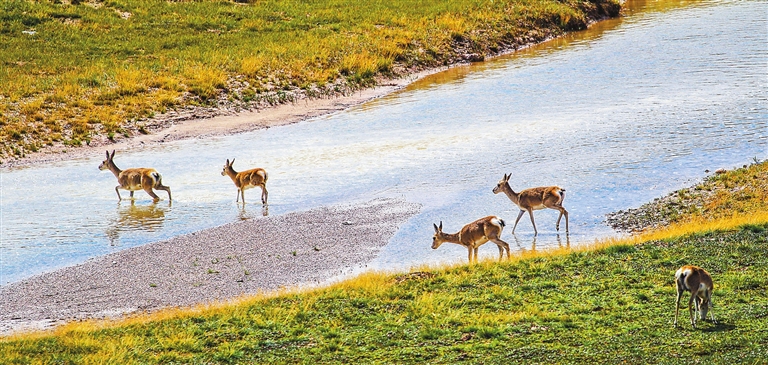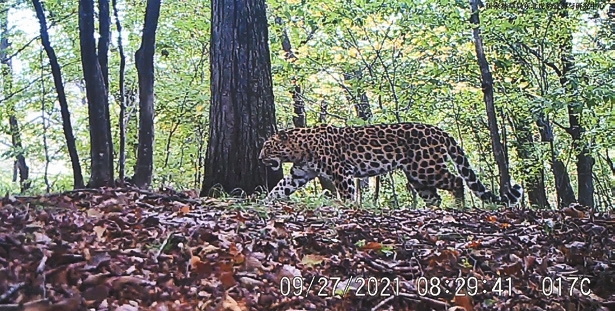


CHINA on Tuesday formally announced its first batch of five national parks, covering a total land area of more than 230,000 square kilometers and conserving nearly 30 percent of the country’s key terrestrial wildlife species. The five parks are the Sanjiangyuan National Park in Qinghai Province and the Tibet Autonomous Region, the Wuyishan National Park in Fujian and Jiangxi provinces, the Giant Panda National Park in Sichuan, Shaanxi and Gansu provinces, the Northeast China Tiger and Leopard National Park in Jilin and Heilongjiang provinces, and the Hainan Tropical Rainforest National Park in Hainan Province. Sanjiangyuan National Park Sanjiangyuan literally means “the source of three rivers.” Located on the Qinghai-Tibet Plateau, Sanjiangyuan, known as the sources of the Yangtze, Yellow and Lancang rivers, is home to hundreds of species of wild animals, many of which are under State protection, such as wild yaks, snow leopards, Tibetan antelopes and Tibetan gazelles. It is also the world’s highest nature reserve with an average altitude of 4,700 meters. The ecological environment of the Sanjiangyuan area has greatly improved in recent years, with ecological and water conservation functions consolidated, and wetland areas expanded. The number of wild animals also saw a significant increase, as the number of Tibetan antelope surpassed 70,000 at present from less than 20,000 in the 1980s, according to Xinhua. China began to establish the Sanjiangyuan Nature Reserve in Qinghai in 2000. The pilot trial operation began in 2016, and official construction started in 2018. Giant Panda National Park The giant panda is a rare species native to China that is beloved worldwide. The Giant Panda National Park on the borders of Sichuan, Shaanxi and Gansu provinces is home to 1,339 wild pandas, 70 percent of China’s total. As an umbrella species, countless creatures which share the habitat with the pandas also gain a better living environment. Rare animals such as golden snub-nosed monkeys and takins also thrive in the area. The park, launched as a national pilot project in January 2017, integrates more than 80 natural reserves in 30 counties of the three provinces. To better protect the wildlife in the park, the Giant Panda National Park Administration has invested 4.7 billion yuan (US$660 million) in infrastructure construction, the restoration of the ecological corridors and the protection of crucial habitats, according to the park administration. About 1,800 monitoring lines and 4,839 observation points have been set up. Northeast China Tiger and Leopard National Park Bordering Russia and the Democratic People’s Republic of Korea, the Northeast China Tiger and Leopard National Park covers an area of 14,100 sq km. It is the major habitat of the country’s Siberian tiger and Amur leopard and is a model for cross-border wildlife conservation. The project was launched in 2017 and has borne fruit, with wildlife populations on the rise. At least 12 Siberian tiger cubs and 11 Amur leopard cubs have been born since 2017. Populations of other wild animals, such as spotted deer and boars, are also on the rise. Over the past four years, the forest stock in the park has risen from 212 million cubic meters to 223 million cubic meters. Hainan Rainforest National Park The Hainan Tropical Rainforest National Park in Hainan Province boasts one of the most concentrated, best preserved and largest contiguous tropical rainforests in China. Covering an area of 4,269 sq km, the park is home to China’s largest rainforest and the Hainan gibbon — a critically endangered species on the International Union for Conservation of Nature’s Red List. The park preserves China’s most complete rain forest on the island and protects the region’s bio-resources. Wuyi Mountain National Park The Wuyi Mountain National Park is the only park in China that is listed as a UNESCO cultural and natural heritage site. Located in the northern part of Fujian Province, it is composed of Wuyi Mountain National Nature Reserve, Wuyi Mountain National Scenic Area and Jiuqu River Upper Reservoir Protection Zone. Covering about 1,280 sq km, the park preserves the world’s largest subtropical primordial forest ecological system on the same latitude zone. Since the pilot program started in 2016, the ecological system of the park has been effectively protected, making it a successful example for establishing a national park within a tourism region. (SD-Agencies) | 
